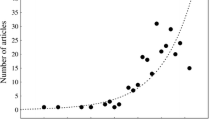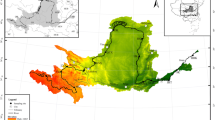Abstract
We record here the occurrence of five exotic fish species viz Oreochromis mossambicus, Gambusia affinis, Osphronemus goramy, Xiphophorus maculatus and Poecilia reticulata in the Chalakudy River, part of the Western Ghats, a global biodiversity hotspot in Kerala, India. O. mossambicus was ubiquitous in occurrence with large shoals being encountered at all sampling sites spread along the downstream-upstream gradient of the river, including at an altitude of 1050 m ASL. Osphronemus goramy was recorded from the downstream region of the river while Gambusia affinis was recorded from three sampling sites located downstream as well as midstream. Xiphophorus maculatus was collected from a second order stream flowing through a tea plantation at an altitude of 1050 m ASL. Samples of brooders and early fry of Poecilia reticulata indicate that the fish has already established a breeding population in the river. Possible threats to the indigenous fish fauna of the Chalakudy River as a result of the invasion and proliferation of these exotics is discussed.
Similar content being viewed by others
Avoid common mistakes on your manuscript.
River Chalakudy (10°10′0″ & 10°33′30″ N and 76°17′0″ & 77°4′0″ E) is the fifth longest (145 km) of the forty four rivers of Kerala State (South India). The river originates, and continues to flow through much of the Western Ghats––a global biodiversity hotspot before joining the Arabian Sea. The river system is known to harbour an exceedingly rich ichthyofauna of around 98 species (Biju et al. 2000; Ajithkumar et al. 1999), many of which are endangered and endemic (Kurup et al., 2003). Chalakudy has also been the focus of much scientific attention owing to the discovery of several new species, Horabagrus nigricollaris, Travancoria elongata, Osteochilus longidorsalis (Pethiyagoda and Kottelat 1994), Garra surendranathinii (Shaji et al. 1998) and Salarias reticulatus (Kurup et al. 2005), most of which are strictly endemic to this river. However, no information is currently available on the occurrence and distribution of exotic fishes in River Chalakudy. A detailed field study carried out as part of the All Catfish Species Inventory Project (ACSI 04-17) of the United States National Science Foundation led to the identification of several exotic species in this river––the results of which have been discussed in the present communication.
Seven sites (Table 1) spread along the downstream-upstream gradient of the Chalakudy River were selected for detailed monthly sampling from July 2004 to June 2005. The sites were chosen such that two of them (Valparai, Malakkapara) was located on a higher elevation zone, three (Anakkayam, Peringalkuthu and Vazhachaal) on mid and the remaining two (Vettilapara and Kanakkankadavu) on low elevation zones, thus maintaining altitudinal differences between them.
Fish collection was carried out at all the seven sites at dawn (05:00–08:00 AM), dusk (05:30–07:30 PM), during the daytime (08:00 AM–05:30 PM) and at night (07:30 PM–05:00 AM). Experimental fishing was carried out using various types of gears including cast nets, gill nets, scoop nets, drag nets, traps and other local contrivances. The representative specimens of the collected fishes were fixed in 10% formaldehyde in plastic bottles and transferred to the laboratory, where they were identified using standard literature (Jayaram 1999, 1981; Talwar and Jhingran 1991; Tekriwal and Rao 1999).
Five exotic fish species viz. Oreochromis mossambicus (Peters 1852), Gambusia affinis (Baird and Girard, 1853), Osphronemus goramy (Lacepede 1801), Xiphophorus maculatus (Gunther 1866) and Poecilia reticulata (Peters 1859) were recorded from the various sampling sites (Table 2).
The Mozambique Tilapia, Oreochromis mossambicus was ubiquitous in occurrence with large shoals being encountered at all sampling sites spread along the downstream-upstream gradient. The fish was also recorded from the headwaters of the river at Valparai at an altitude of 1,050 m ASL. Our sightings of tilapia at Valparai (1,050 m ASL) merits attention since earlier reports from India mention that this species do not thrive in higher altitudes with low temperature. Also, Balarin (1979) had suggested that tilapia thrive at an elevation below 1,000 m ASL and that in Uganda there were no tilapia at elevations of above 200 m.
Several cases of fish species decline from various water bodies in India including reservoirs and rivers due to proliferation of tilapia have been documented (Jhingran 1984). The presence of a well established population of tilapia in the Chalakudy River will invariably cause negative effects on the native fish fauna of the region. Taking into consideration the tropic status of O. mossambicus, we believe that an immediate threat to a native species would be to the Orange Chromide Etroplus maculatus. An important native ornamental fish of River Chalakudy, E. maculatus shares more or less the same resources as that of O. mossambicus and so the proliferation of the former will invariably harm the native stocks of E. maculatus.
Samples of Poecilia reticulata and Xiphophorus maculatus, two of the most common aquarium fish species worldwide were collected from a second order stream that flows through a tea plantation at Valparai (1,050 m ASL). Samples of brooders as well as early fry of Poecilia reticulata collected from the study site indicate the reproductive potential of the fish, and also the fact that it has already established a breeding population in the river. Since the males of the species mature at 2 months and females at 3 months of age, the species has every chance of proliferating to become a potential pest in the river system thereby affecting the native fish fauna.
Daniels (2003) had commented on the occurrence of X. maculatus in Valparai and suggested that the species had become sympatric with the indigenous Melon Barb, Puntius fasciatus (Jerdon 1849) in the streams that flow through tea plantations. The insectivorous feeding habit of X. maculatus make them potential competitors for indigenous barbs like Puntius fasciatus, Puntius ticto (Hamilton 1822) Puntius vittatus (Day 1865) and Killi Fishes like Aplocheilus lineatus (Valenciennes 1846) Aplocheilus panchax (Hamilton 1822) and Aplocheilus dayi (Steindachner 1892) which are highly popular ornamental fish species found in River Chalakudy, and which were found to co-exist with X. maculatus in the stream habitats. Since X. maculatus has not been listed in Fishbase (Froese and Pauly 2006) as introduced into India, we believe that the fish were discarded by thoughtless aquarists from homes close to tea plantations. As in the case of P. reticulata, X. maculatus also attain sexual maturity after 3–4 months and reproduce easily and could invariably turn potential pests in the near future.
Osphronemus goramy was recorded from Kanakkankadavu (5 m ASL) located in the downstream region of the river while Gambusia affinis was recorded from three sampling sites, one downstream and two in the midstream. Although, O. goramy has not been considered as a pest in many of the areas where they were introduced, we believe that its co-occurrence with a popular native ornamental species, Pseudosphromenus cupanus (Cuvier 1831) would lead to competition for habitat and food.
Gambusia affinis is considered to be highly effective in mosquito control and has been widely introduced, but have been found to compete with indigenous fish and upset the ecological balance in many regions of the world (Froese and Pauly 2006). They are known to prey upon the eggs and juveniles of other fish species and have been linked to the decline of frog species, through the predation of tadpoles and adult frogs (New South Wales, Department of Primary Industries 2006). This is also an area of outmost anxiety as the Western Ghats are known to be a gold mine of endemic amphibian fauna. Being a prolific breeder with an extended breeding season, this species may also overwhelm suitable habitats of native species with fingerlings and deplete food supplies. G. affinis is also known to deny co-existing species access to a particular resource, generally through aggressive behaviour including chasing and fin nipping which can lead to secondary bacterial or fungal infections, finally resulting in the death of other fish (New South Wales, Department of Primary Industries 2006).
Previous literature indicates that at least four among the five exotic species that we collected from River Chalakudy have the status of ‘potential pests’. Their occurrence and possible spread through the river system could spell doom for the many endemic and threatened native ornamental fish species. Our findings on the occurrence of exotic fish species in a fish diversity hotspot like Chalakudy is of critical concern since the river harbours many endemic and threatened fish species that have small population sizes that have higher chances of getting endangered. An urgent need has therefore arisen to look into the possible impacts that the exotic fish species may have on the native fish fauna especially the ornamental species of River Chalakudy. Detailed investigations should be carried out into aspects of species interactions (native-exotic and exotic-exotic), habitat alterations, genetic deterioration as well as introduction of parasites and diseases.
References
Ajithkumar CR, Remadevi K, Thomas KR, Biju CR (1999) Fish fauna, abundance and distribution in Chalakudy river system, Kerala. J Bombay Nat Hist Soc 96(2):244–254
Balarin JD (1979) Tilapia. A guide to their biology and culture in Africa. University of Stirling, Stirling, Scotland. 174 p
Biju CR, Thomas KR, Ajitkumar CR (2000) Ecology of hill streams of the Western Ghats with special reference to fish community, final report 1996–1999. Project report submitted to Bombay Natural History Society, Bombay, India
Daniels RJR (2003) Impact of tea cultivation on the anurans in the Western Ghats. Curr Sci 85(10):1415–1422
Froese R, Pauly D (eds) (2006) Fishbase world wide web electronic publication. http://www.fishbase.org version (10/2006)
Jayaram KC (1981) Fresh water fishes of India–Hand book. Zoological survey of India, Calcutta, India
Jayaram KC (1999) The freshwater fishes of the Indian region. Narendra Publishing house, New Delhi, 509 pp
Jhingran AG (1984) The fish genetic resources of India. Bureau of fish genetic resources. Allahabad and Maya Press Pvt. Ltd., Allahabad, India, 83 p
Kurup BM, Radhakrishnan KV, Manojkumar TG (2003) Biodiversity status of fishes inhabiting rivers of Kerala (S. India) with special reference to endemism, threats and conservation measures. In: Wellcome RL, Petr T (eds) Proceedings of LARS2. 2nd large rivers symposium. Phnom Penh. 11th to 14th February 2003. pp 163–182
Kurup BM, Manojkumar TG, Radhakrishnan KV (2005) Salarias reticulatus–a new freshwater blenny from Chalakudy River, Kerala, South India. J Bombay Nat Hist Soc 102(2):195–197
New South Wales, Department of Primary Industries. (2006). http://www.fisheries.nsw.gov.au/aquatic_habitats/aquatic_habitats/alien_fish, cited 24th January 2007
Pethiyagoda R, Kottelat M (1994) Three new species of fishes of the genera Osteochilichthys (Cyprinidae), Travancoria (Balitoridae) and Horabagrus (Bagridae) from the Chalakudy River, Kerala, India. J South Asian Nat Hist 1(1):97–116
Shaji CP, Arun LK, Easa PS (1998) Garra surendranathini–A new cyprinid fish from the South Western Ghats. J Bombay Nat Hist Soc 93(3):572–575
Talwar PK, Jhingran AG (1991) Inland fishes of India and adjacent countries. Vol I & II, Oxford & IBH Publishing Co., Pvt. Ltd., New Delhi, 1158 pp
Tekriwal KL, Rao AA (1999) Ornamental and aquarium fish of India. Kingdom Books, P. O. Box 15 Waterloo Ville PO 7 6 B Q, England, 144 p
Acknowledgements
The authors are grateful to Dr. Larry Page, Florida Museum of Natural History (FLMNH) for generous grants of funds through the All Catfish Species Inventory Project (ACSI). Thanks are also due to the graduate students of the Department of Aquaculture, St. Albert’s College for their unstinted help during the field trips.
Author information
Authors and Affiliations
Corresponding author
Rights and permissions
About this article
Cite this article
Raghavan, R., Prasad, G., Anvar-Ali, P.H. et al. Exotic fish species in a global biodiversity hotspot: observations from River Chalakudy, part of Western Ghats, Kerala, India. Biol Invasions 10, 37–40 (2008). https://doi.org/10.1007/s10530-007-9104-2
Received:
Accepted:
Published:
Issue Date:
DOI: https://doi.org/10.1007/s10530-007-9104-2




